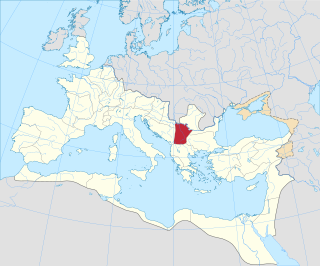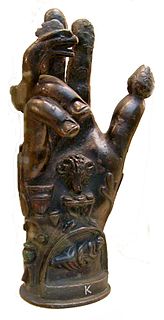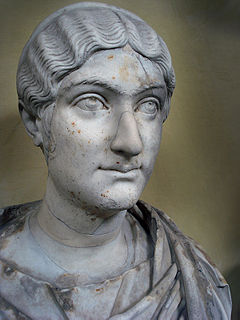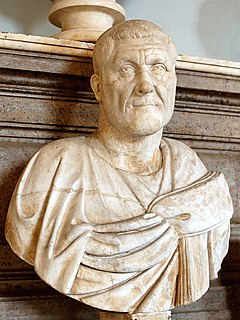Related Research Articles

The Battle of Abritus, also known as the Battle of Forum Terebronii, occurred near Abritus in the Roman province of Moesia Inferior in the summer of 251. It was fought between the Romans and a federation of Gothic and Scythian tribesmen under the Gothic king Cniva. The Roman army of three legions was soundly defeated, and Roman emperors Decius and his son Herennius Etruscus were both killed in battle. They became the first Roman emperors to be killed by a foreign enemy. It was one of the worst defeats suffered by the Roman Empire against the Germanic tribes, rated by the Roman historian Ammianus Marcellinus as on par with the Battle of the Teutoburg Forest in 9 AD, the Marcomannic invasion of Roman Italy in 170, and the Battle of Adrianople in 378.
The 230s decade ran from January 1, 230, to December 31, 239.
The 240s decade ran from January 1, 240, to December 31, 249.

Year 244 (CCXLIV) was a leap year starting on Monday of the Julian calendar. At the time, it was known as the Year of the Consulship of Armenius and Aemilianus. The denomination 244 for this year has been used since the early medieval period, when the Anno Domini calendar era became the prevalent method in Europe for naming years.
Year 238 (CCXXXVIII) was a common year starting on Monday of the Julian calendar. At the time, it was known as the Year of the Consulship of Pius and Pontianus. The denomination 238 for this year has been used since the early medieval period, when the Anno Domini calendar era became the prevalent method in Europe for naming years.

Moesia was an ancient region and later Roman province situated in the Balkans south of the Danube River, which included most of the territory of modern-day Serbia, Kosovo, the north-eastern parts of Albania and the northern parts of North Macedonia, the whole of Northern Bulgaria, Romanian Dobruja and small parts of Southern Ukraine.

Gordian III was Roman emperor from 238 to 244. At the age of 13, he became the youngest sole Roman emperor. Gordian was the son of Antonia Gordiana and Junius Balbus who died before 238. Antonia Gordiana was the daughter of Emperor Gordian I and younger sister of Emperor Gordian II. Very little is known of his early life before his acclamation. Gordian had assumed the name of his maternal grandfather in 238.

Gordian I was Roman emperor for 22 days with his son Gordian II in 238, the Year of the Six Emperors. Caught up in a rebellion against the Emperor Maximinus Thrax, he was defeated by forces loyal to Maximinus, and he committed suicide after the death of his son.

Gordian II was Roman emperor with his father Gordian I in 238, the Year of the Six Emperors. Seeking to overthrow Maximinus Thrax, he died in battle outside Carthage. Since he died before his father, Gordian II had the shortest reign of any Roman emperor, at 22 days.

Philip the Arab was Roman emperor from 244 to 249. He was born in Aurantis, Arabia, in a city situated in modern-day Syria. After the death of Gordian III in February 244, Philip, who had been Praetorian prefect, achieved power. He quickly negotiated peace with the Persian Sassanid Empire and returned to Rome to be confirmed by the senate. During his reign, the city of Rome celebrated its millennium.

Sabazios is the horseman and sky father god of the Phrygians and Thracians. In Indo-European languages, such as Phrygian, the -zios element in his name derives from dyeus, the common precursor of Latin deus ('god') and Greek Zeus. Though the Greeks interpreted Phrygian Sabazios as both Zeus and Dionysus, representations of him, even into Roman times, show him always on horseback, as a nomadic horseman god, wielding his characteristic staff of power.

Decimus Caelius Calvinus Balbinus was Roman emperor with Pupienus for three months in 238, the Year of the Six Emperors.

The Battle of Misiche, Mesiche (Μεσιχή), or Massice was fought between the Sasanians and the Romans in Misiche, Mesopotamia.
Antonia Gordiana was a prominent, wealthy and noble Roman woman who lived in the troubled and unstable 3rd century. She was the daughter of Roman Emperor Gordian I; sister to Roman Emperor Gordian II and mother to Roman Emperor Gordian III. The Augustan History names her as Maecia Faustina, however modern historians dismiss this name as false. She was most probably born in Rome. Along with her elder brother they were raised and spent their childhoods in the house that Roman Republican General Pompey had built in Rome. Previous owners included Roman Triumvir Mark Antony and Roman Emperor Tiberius.

Furia Sabinia Tranquillina was the Empress of Rome and wife of Emperor Gordian III. She was the young daughter of the Praetorian Prefect Timesitheus by an unknown wife.
Gaius Furius Sabinius Aquila Timesitheus was an officer of the Roman Imperial government in the first half of Third Century. Most likely of Oriental-Greek origins, he was a Roman citizen, probably of equestrian rank.

Gaius Julius Verus Maximinus "Thrax" was Roman emperor from 235 to 238.

The Gordian dynasty, sometimes known as the Gordianic dynasty, was short-lived, ruling the Roman Empire from 238 to 244 AD. The dynasty achieved the throne in 238 AD, after Gordian I and his son Gordian II rose up against Emperor Maximinus Thrax and were proclaimed co-emperors by the Roman Senate. Gordian II was killed by the governor of Numidia, Capillianus and Gordian I killed himself shortly after, either 21 or 36 days after he was declared emperor. On 22 April 238, Pupienus and Balbinus, who were not of the Gordian dynasty, were declared co-emperors but the Senate was forced to make Gordian III a third co-emperor on 27 May 238, due to the demands of the Roman people. Maximinus attempted to invade Italy but he was killed by his own soldiers when his army became frustrated. After this, the Praetorian Guard killed Pupienus and Balbinus, leaving Gordian III as the sole emperor. Gordian III ruled until AD 244 when he was either killed after his betrayal by Philip the Arab, killed by Philip the Arab or killed at the Battle of Misiche; with his death, the dynasty was ended and Philip the Arab became emperor.
References
- ↑ Herodian. "Roman History". Archived from the original on 22 September 2015. Retrieved 2015-05-02.